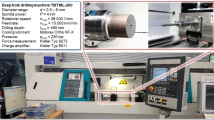Abstract
Growing competitive pressure forces companies to optimise process productivity and shorten primary production times. At the same time, the resulting manufacturing quality must be kept on a high level. In the automotive sector, deep hole drilling with smallest tool diameters is an important process, e.g. to produce lubrication holes in crankshafts and fuel channels in injectors. A crucial criterion for the achievable productivity and manufacturing quality with respect to the dimensional and shape tolerances as well as the surface quality in smallest diameter deep hole drilling is the chip formation. Therefore, in-depth analyses regarding the mechanisms of chip formation at the cutting edge and the chip removal along the chip flutes are indispensable. To accomplish an in-depth chip formation analysis in smallest diameter deep hole drilling, a new methodology of analysis has been developed. Samples made of the particular test material are inserted into acrylic glass carriers, and the chip formation in the operating zone and the chip removal are documented by high-speed microscopy. In this paper, the experimental setup of the newly developed methodology of analysis and the experimental results for single-lip and twist deep hole drilling of high-strength bainitic steel with smallest diameters are shown. The investigations show the dependence of chip formation on the changes of the microstructure of the cutting edge due to tool wear, and form the basis for an optimization of the tools. In addition to that, a new approach to visualise machining processes running under non-transparent coolant is presented.
Similar content being viewed by others
References
VDI-Richtlinie 3208 (2014) Tiefbohren mit Einlippenbohrern. Beuth-Verlag, Berlin
VDI-Richtlinie 3210 (2006) Tiefbohrverfahren. Beuth-Verlag, Berlin
Eichler R (1996) Prozeßsicherheit beim Einlippentiefbohren mit kleinen Durchmessern. Universität Stuttgart, Dissertation
Heilmann M (2012) Tiefbohren mit kleinen Durchmessern durch mechanische und thermische Verfahren. Technische Universität Dortmund, Dissertation
Kirschner M (2016) Tiefbohren von hochfesten und schwer zerspanbaren Werkstoffen mit kleinsten Durchmessern. Technische Universität Dortmund, Dissertation
Denkena B, Biermann D (2014) Cutting edge geometries. CIRP Ann Manuf Technol 63(2):631–653. https://doi.org/10.1016/j.cirp.2014.05.009
Okasha MM, Mativenga PT, Li L (2011) Sequential laser mechanical microdrilling of Inconel 718 alloy. J Manuf Sci Eng 133(1):011008. https://doi.org/10.1115/1.4003334
Imran M, Mativenga PT, Kannan S, Novovic D (2008) An experimental investigation of deep hole microdrilling capability for a nickel-based superalloy. J Eng Manuf 222(12):1589–1596. https://doi.org/10.1243/09544054JEM1217
Biermann D, Kirschner M (2015) Experimental investigations on single-lip deep hole drilling of superalloy Inconel 718 with small diameters. J Manufacturing Processes, 20 1:332–339
Heisel U, Stortchak M, Eisseler R (2003) Determination of cutting parameters in deep hole drilling with single-fluted gun drill of smallest diameters. Prod Eng X(/1):51–54
Zabel A, Heilmann M (2012) Deep hole drilling using tools with small diameters—process analysis and process design. CIRP Annals–Manufacturing Technol, 61(1):111–114. https://doi.org/10.1016/j.cirp.2012.03.002
Fink PG (1977) Zerspanungsuntersuchungen zur Verbesserung der Spanabführung, der Bohrungsqualität sowie der Wirtschaftlichkeit beim Tiefbohren mit Einlippen-Werkzeugen. Universität Stuttgart, Dissertation
Heisel U, Wallaschek J, Eisseler R, Potthast C (2008) Ultrasonic deep hole drilling in electrolytic copper ECu 57. CIRP Annals–Manufacturing Technol 57(1):53–56. https://doi.org/10.1016/j.cirp.2008.03.078
Schur S (2008) Mit axialem Pulsieren zu höherem Vorschub–Hochleistungs-Tiefbohren mit dem Axial-Pulsator. Werkstatt und Betrieb 4:2–4
B. Denkena, H. K. Tönshoff: Spanen–Grundlagen. Springer Verlag, 3. Auflage, Heidelberg, (2011)
Klocke F, König W (2008) Fertigungsverfahren–Drehen, Fräsen, Bohren. 8. Auflage. Springer-Verlag, Heidelberg
Griffiths BJ (1986) The development of a quick-stop device for use in metal cutting hole manufacturing processes. Int J Machine Tool Design Res, 26(2):191–203. https://doi.org/10.1016/0020-7357(86)90219-2
Biermann D, Kirschner M, Eberhardt D (2014) A novel method for chip formation analyses in deep hole drilling with small diameters. Production Engineering–Res Developments, 8(4):491–497. https://doi.org/10.1007/s11740-014-0566-7
H. Opitz: Die Aufbauschneidenbildung bei der spanabhebenden Bearbeitung. Westdeutscher Verlag, Köln und Opladen, (1964), https://doi.org/10.1007/978-3-322-98657-3
Funding
The authors would like to thank the German Research Foundation (DFG) for funding the project BI 498/67 “High-speed analysis of the chip formation in small diameter deep hole drilling of high-strength and difficult-to-machine materials”.
Author information
Authors and Affiliations
Corresponding author
Rights and permissions
About this article
Cite this article
Kirschner, M., Michel, S., Berger, S. et al. In situ chip formation analyses in micro single-lip and twist deep hole drilling. Int J Adv Manuf Technol 95, 2315–2324 (2018). https://doi.org/10.1007/s00170-017-1339-1
Received:
Accepted:
Published:
Issue Date:
DOI: https://doi.org/10.1007/s00170-017-1339-1




